It's worth mentioning that as Kolin and his team were developing this post over the past few weeks (which is the culmination of years of testing and documentation), we became aware of some discussions in a couple online climbing forums and blogs filled with rumors and misinformation about BD crampons and the people who work here. We watched the discussion—dominated by a handful of posters with well-documented personal vendettas against us—devolve into a series of irrational personal attacks, lies paraded as insider knowledge, and misleading and bullying of fellow forum members who voiced support for BD or asked for facts to support the claims. As the vitriol became more and more erratic, personal and baseless, we realized it would be best not to engage in such dialogue that is unconstrained by facts or respect.
Fortunately, KP and his crew continued developing this post, and we feel this serves to bring all the facts to the table. This QC Lab provides the technical data and crucial manufacturing insights for climbers who want to be fully and properly informed on crampons: how they are designed, how they are built, the materials used, how they are tested, why they break, how often they break, and how to increase their lifespan.
We realize that to some people, to innovate is to disrupt; it makes them uncomfortable. This is nothing new. When we made the climbing world's first wiregate carabiner or carbon fiber ice tool, there were doubters who were spooked by the nonconformity and innovation of our designs and materials. And now? Those radical designs and revolutionary materials have become iconic standards of innovation in climbing equipment. Building our crampons out of stainless steel is just another step down that path of innovation.
Climbing is not merely our business—it's our life, it's our passion, it's what we do—and all of us here at Black Diamond Equipment are obsessively dedicated to innovating, designing and building the absolute best gear possible in support of you, our fellow climbers. Stainless steel crampons have become, by far, our best selling models of all time—a point of pride we share with every climber, from paid professional to weekend warrior, who uses our crampons. We appreciate your feedback, your vision, and your stoke, and are continually humbled by the summits and climbs you have achieved with our equipment.
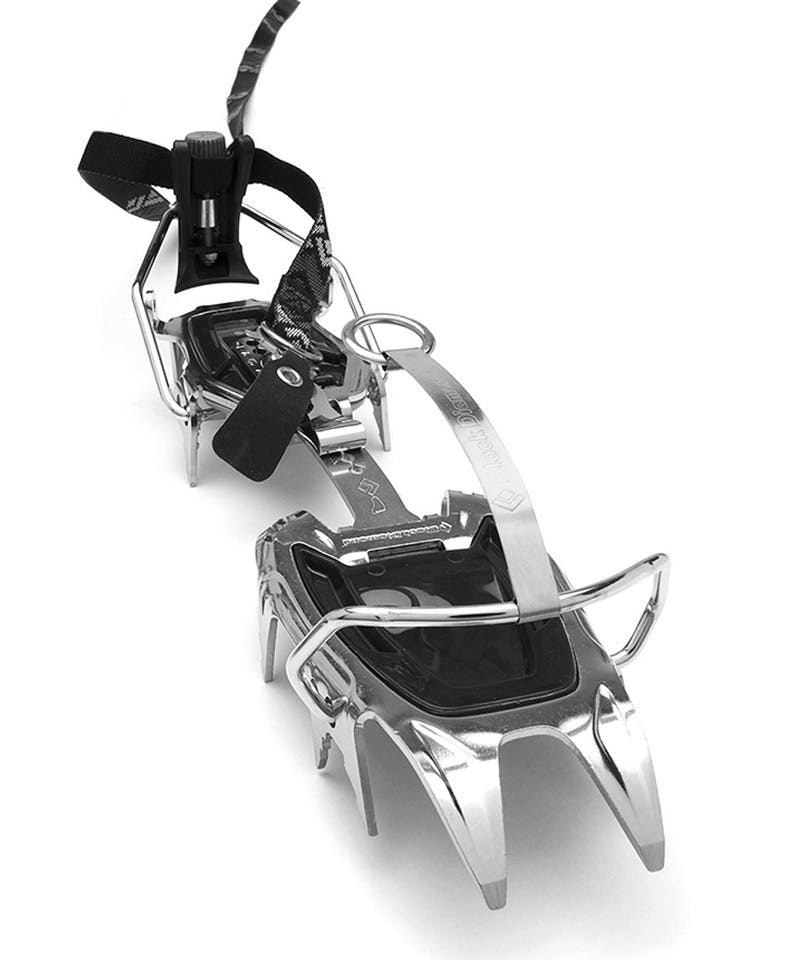
In the last QC Lab post we covered ice tool picks—why and how they break, CE requirements for picks, some testing we do here at BD, how different types of picks are oftentimes more suited for particular application, and that they don't last forever. This time it's crampons, which, you guessed it, also don't last forever. In this post we'll not only delve into why crampons don't last forever, but also why you must select the right tool for the job in order to get maximum performance and lifespan out of your gear.
CRAMPON DESIGN
It's tough to clearly categorize crampons nowadays. Years ago there was "hinged" and "rigid". There aren't a lot of truly rigid crampons around anymore—most frames are of a similar hinged design. One could argue that it may make the most sense to categorize them into vertical front points (for waterfall ice) and horizontal front points (for alpine and snow).
Vertical Front Points
- They are typically more rigid and provide a more solid platform for front pointing.
- Think of the front points as 2x6s placed vertically for added rigidity.
- They climb vertical ice better (less ice shattering), plus it's possible to track in your pick placements and get the points into cracks when mixed climbing.
- The added rigidity results in them being able to take more cyclic abuse before the metal fatigues.
- The downside is they are heavier.
Horizontal Front Points
- Points are oriented for more surface area for better purchase while snow climbing.
- Think of the front points as 2x6s placed horizontally for a wider, but less rigid, purchase area.
- They are lighter.
- The downside is that because they're lighter (i.e., less material) they generally can't take the amount of abuse as a pair of vertically oriented front point crampons.
CE REQUIREMENTS
Most crampons on the market adhere to the CE (EN893) and UIAA 153 requirements. These requirements include: minimum length of spikes, prevention against slippage, bending and breaking strength of spikes, strength of bails and retention system and strength of the frame. For a bit more insight into the CE and UIAA requirements for crampons, click here to go to the UIAA's webpage on safety standards.
ADDITIONAL TESTING
As with all BD products, we are obsessively dedicated to designing and building the absolute best gear possible (which means going above and beyond CE and UIAA standards), so we have created a battery of testing machines and tests that our crampons need to go through before they hit the market, including: fatigue testing, material wear testing, ultimate strength testing, crampon balling testing, high and low temperature testing, salt spray testing, UV testing and, of course, the fun part: field testing.
MANUFACTURING
Nearly every single manufacturer uses the same combination of the following processes: vertical front points are hot forged; frames and horizontal front points are stamped, laser cut, milled or water jet from sheet and then cold formed. We do the entire crampon manufacturing downstairs here at BD HQ, and it's cool to go down there and watch the process unfold.
CRAMPON MATERIAL SELECTION
Crampons are built with two basic materials: aluminum and/or steel. (And as shown in this photo, climbers on a super-thin budget have been known to bang together a homemade pair out of wood, duct tape and screws...)
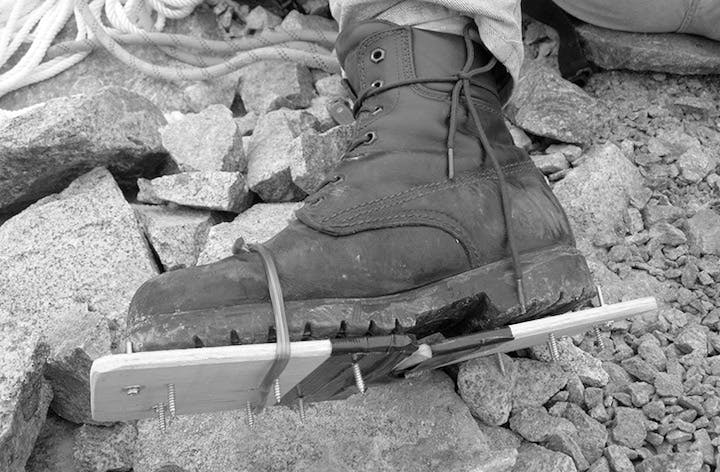
Aluminum is lighter than steel, but also not as burly—so you'll usually see aluminum crampons as non-technical products intended for snow/glacier travel only. Take a pair of aluminum crampons on a waterfall ice climb or walking over rocks, and they will be a bent and busted mess in no time.
Steel is the common material of choice: chromoly or stainless, with many different compositions of each available. As far as weight, steel is steel and there really isn't much variation, however, different steels have different advantages and disadvantages when it comes to manufacturability and performance characteristics: machinability, formability, hardness, toughness, wear, durability, and, of course, cost.
CHROMOLY TO STAINLESS
A few years ago, Black Diamond switched from using chromoly steel to stainless steel for our crampons. The reason? Stainless, though roughly three times more expensive than chromoly, is less susceptible to rust, doesn't require toxic paint or powder coating, performs better and, as a bonus, looks cool. As climbers, we count on stainless steel in critical areas every day: most newer bolts and bolt hangers are stainless; cables, ball swages and many parts on cams are stainless; and many ice axe heads, spikes, crampon and ice tool components use stainless. But before we made the switch on our crampons, we did a ton of testing to verify material selection. As well as targeting all of the CE and UIAA requirements, we performed our battery of additional tests: wear testing, crampon balling testing, fatigue testing.
What did we learn about stainless?
Field Testing: We tested stainless steel crampon protos around the globe for more than two years, from single-pitch mixed rigs to multi-day Himalayan giants to free solos in the Canadian Rockies, by some of the top climbers in the game (as well as some of the top hacks in the game—myself included). Athletes, testers, and employees put the stainless steel protos through pitch after pitch of use and experienced significant improvements in several performance characteristics (see below).
Wear: In our field testing and point wear test comparison in the QC Lab, we saw improved point durability in the stainless we selected over our previously used chromoly. Point geometry and rust (see below) were also significant contributors to how quickly points became dull.
Snow Balling: When brand new the stainless steel sheds snow about the same as a brand new powder-coated chromoly crampon. However, we noticed in the lab and in the field that when comparing used powder-coated chromoly crampon to a used stainless steel crampon, the stainless, with its smooth finish, sheds snow significantly better than the chromoly with its scrappy, flaked off powder coating.
Rust: In our non-calibrated salt-spray comparative testing, the chromoly crampons became completely rusted while the stainless crampons showed virtually no signs of rust, save for the toe bails and center bars, which are not made from stainless steel. By pitting and corroding the chromoly, rust acts as a wear accelerant, especially on the tips of the points. No rust = less snow balling and better long-term durability.
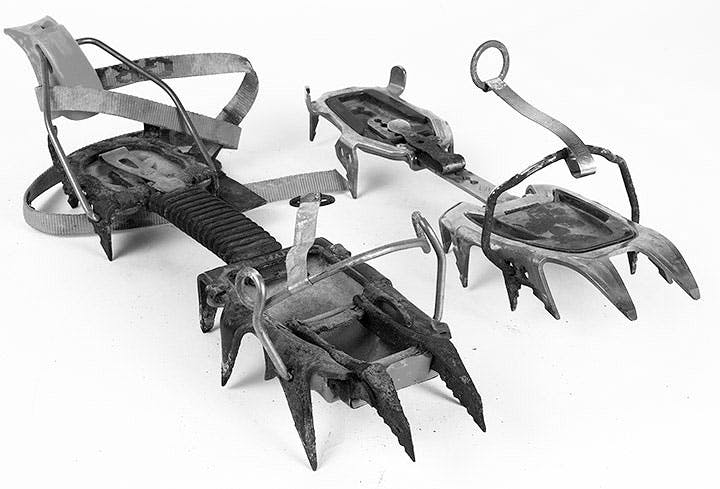
Fatigue: As noted in the previous QC Lab post regarding ice-tool picks, there is no official CE requirement for the fatigue life of crampons (or any climbing gear, for that matter). Fatigue life and optimizing the gear we make is extremely important to us, so, CE requirement or not, we designed and built our own crampon-specific cyclic machine (three actually) that test fatigue life (think: bending a coat hanger back and forth over and over until it breaks). Our goal was to determine if there was a significant difference in fatigue life based on material selection, geometry specifics, varying the loads, placement of loads, frequency of loads, etc. We cut old geometry out of stainless, we cut new geometry out of chromoly, we tested old Black Diamond products, other manufacturers products, and many iterations of prototypes—all in order to get a true understanding of where geometries, materials and the competition all stacked up as it pertains to cyclic durability. Overall, we tested hundreds of crampons, and continue to test as new styles and various performance characteristics adjustments are developed.
Below is a graph that shows a variety of front-point cyclic fatigue comparisons of BD Cyborg and Sabretooth crampons in both stainless and chromoly. What this test showed us was that, in regards to fatigue life, stainless steel was in the same ballpark as chromoly.
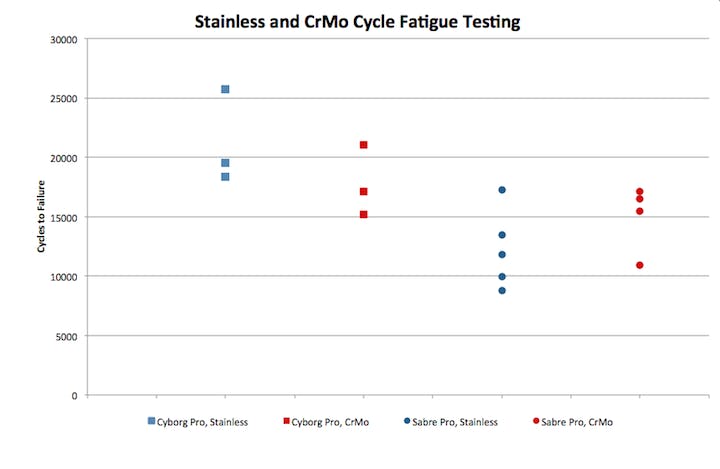
Crampons Break
Even given all of the design work, material selection and testing that Black Diamond and most other manufacturers perform, under certain circumstances—and as with picks and most any gear—crampons won't last forever. Crampons can and do wear out or break in the field—they always have. Points can become dull and eventually too short from continuous sharpening, bails can get tweaked, bent or rusted, points can bend or break from being torqued in a crack or heavily, single-point loaded during climbing or even walking (often while descending on hard ice or rocks), and points, center bars or crampon frames can ultimately break from the continuous pounding from metal fatigue.
In 2001, the British Mountaineering Council created a pamphlet to help educate climbers on gear, its uses, limitations, gear maintenance and inspection. Here's an excerpt from the pamphlet regarding crampons:
Crampons take an incredible amount of punishment – a climber carrying a heavy rucksack and walking over rock or boulders transfers a large force onto the points of the crampon. (For the technically minded the impact force can be around 3kN, which on rough terrain might be shared by only two or three of the points!). Also the crampon bends slightly, even on the stiffest boot, and this happens on every step.
On a ten-mile walk a crampon could experience 10,000 bending cycles. Metal will break if cold enough and either bent with sufficient force (brittle fracture) or flexed back and forward enough times (fatigue failure). The surprising thing is not that some crampons break but rather that most crampons don't break – a testament to our equipment manufacturers.
Click here to read various reports—albeit ones that are a bit dated—that the British Mountaineering Council posted on their website about crampon and all kinds of other gear field breakages.
How Often Do Crampons Break?
The BMC pamphlet reports only 31 crampon field failures over a 15-year period. Not many. But remember that this information is from more than a decade ago. The current reality is that gear makers are pushing the limits of design (i.e., making gear lighter and more performance oriented, which usually comes at a cost of durability) and climbers are being harder and harder on gear because climbing styles and difficulty have changed so much in recent years.
Crampons break; they always have. No manufacture has a magic material or process to produce an unbreakable crampon. Every company has warranty returns, but all I will cover here are crampons that have been returned to Black Diamond. Our data includes everything from a broken frame or center bar to a slightly frayed strap to an ABS plate that has baked and melted in a car fire. All inclusive, our historical return rate for crampons is less than 0.1%. Specifically, crampon warranty return rates were around 0.06% for the eight-year period prior to using stainless steel, and around 0.02% since switching to stainless in 2009— as you can see in the chart below. We have rarely ever seen vertical front point crampons returned (remember that 2x6 analogy), so if we divide the warranty return rate down by model, it creeps close to 0.2% for technical crampons with horizontal front points (not shown specifically in this graph).
How Do Crampons Break?
Every piece of climbing gear returned to BD Warranty eventually comes across my desk. We in the QC Lab analyze the returns and complete a comprehensive investigation. We treat every return as a serious opportunity to understand what happened, how it happened, and what's going on in the field, as well as an opportunity to improve our products through refinements and meaningful design tweaks. Even though all of our crampons exceed all international standards, we do not hesitate to improve and optimize them based on real-world usage.
Historically here at BD, we would see a few random crampon returns for frayed webbing, plastic toe straps getting beat, bent front points or tweaked down-points. Sometimes we would see bent or broken rear down-points—usually from people descending hard ice or rocks and the heel down-points taking the brunt of the load. And sometimes we have seen broken crampon frames or center bars—often returned from trekking companies whose crampons see tons of mileage on glaciers, usually with people wearing really soft boots that flex a lot and cause a bending load on the frame.
We all know you can break anything if you try hard enough and that there have been and always will be anomalous failure modes. While investigating a couple of crampon warranty returns from this past season, we noticed a direct correlation: As crampons have gotten more and more specialized and lighter (20 years ago, crampons weighed upwards of 1400 grams per pair, now you're seeing technical crampons as low as 800 grams per pair), boots are getting more asymmetric and significantly more flexible (think old plastic boots that were comfortable to climb in but made walking feel like you had wooden planks nailed to your feet vs. the comfort of today's flexible, rockered leather boots). Unfortunately these two trends contribute negatively to the durability of a crampon. (It's worth noting that currently there are no significant CE requirements for boot soles or the crampon/boot interface or compatibility, though this topic is being discussed in annual meetings of the UIAA Safety Commission, which I attend on behalf of Black Diamond.)
Back in the day, when people were climbing vertical ice with big, heavy rigid plastic boots, it was the boot—not the crampon—that was taking the bending load during climbing. But now with the popularity of lighter and more flexible boots, the crampon ends up taking the bending load as you're front pointing. And as the BMC article states: metal fatigue by bending is one of the main factors that lead to crampons breaking. This, of course, is exacerbated as the load increases (heavier climbers) and as the moment arm increases (bigger feet). What does all that mean in regards to boots? It means that when climbing in modern day (more flexible) boots, a big, heavy guy with big feet is going to abuse a crampon more than a lighter woman with small feet.
Check out the animated gifs below that show how much boots flex when loaded by an 80kg climber, front pointing in size 45 boots. You can see that the old plastic boots have virtually zero flex and therefore transfer virtually zero bending load to the crampon. The other two boots are popular current models, one lightweight ice boot and one medium weight mountain boot—the amount of bending load transferred to the crampon is dramatically
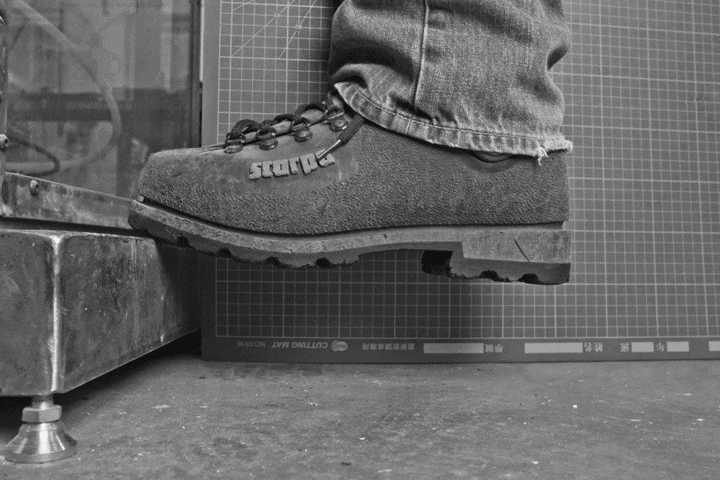
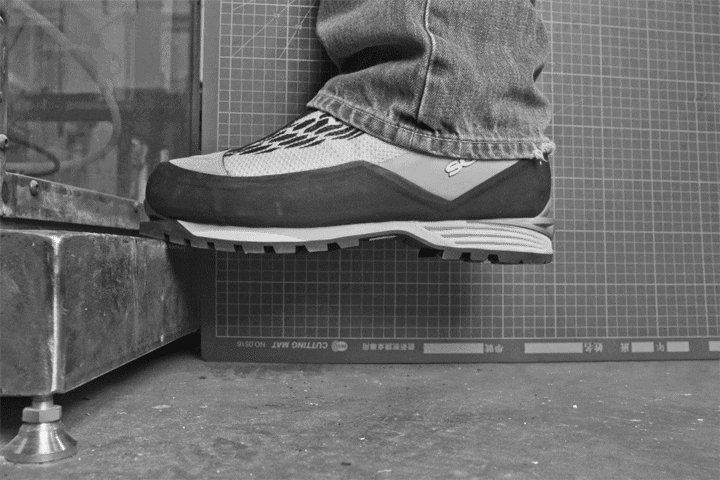
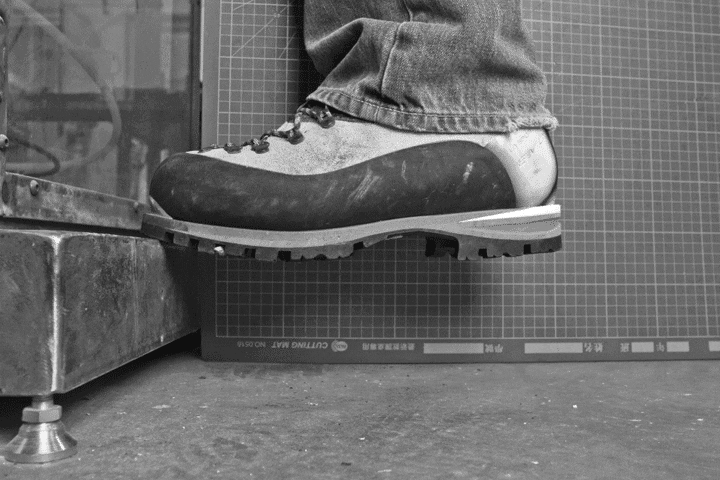
What can you do?
Crampons
I don't think we've ever seen a vertically oriented front point crampon frame break, but we have seen horizontally oriented front point frames break. As a general rule beefier crampons with vertical front points performed better in cycle fatigue than lighter crampons with horizontal front points. This should be no surprise. So if you are planning on doing a lot of front pointing on water ice or you're an Alpine MOG that tips the scales over the 90kg level, you will best be served with a vertical front point crampon.
We wanted to be able to put some actual numbers to the difference in fatigue life, so we did a comparison on our homemade cyclic machine that represents repeated front pointing. And, as always, we not only tested our own current-model crampons but also other manufacturers.
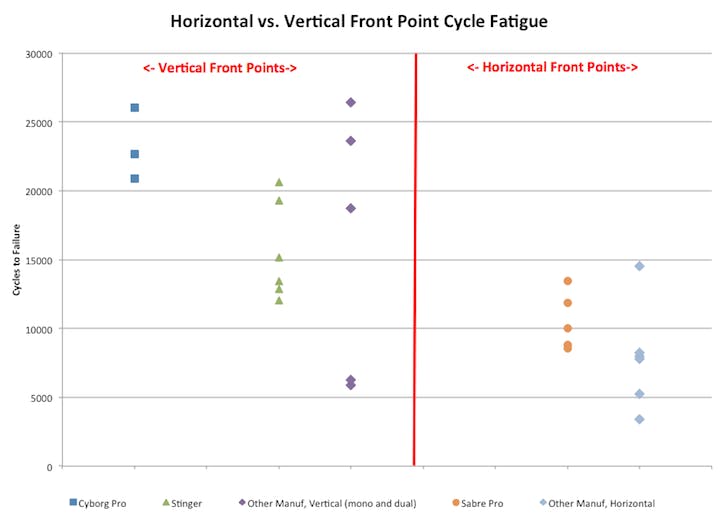
As you can see, pretty much across the board, vertically oriented front points do better than horizontal. Once again, this increased durability is from the vertical oriented front points increasing stiffness and being able to take more abuse before fatigue.
Boots and Center Bars
Proper boot selection and fit to the crampon is critical in optimizing performance and maximizing lifespan. If you're using a boot that has lots of flex, a flexible center bar allows the crampon to move with the boot, thus reducing the bending load forces on the front frame of the crampon.
We wondered how different boot and center bar combinations affected the lifespan of crampons—so we tested it. We ended up comparing how many cycles a crampon could take before failure, depending on which boot was used:
- a soft hiking boot
- mid-stiff boot (modern day, typically used for climbing vertical ice)
- truly rigid (plastic) boot.
As well as, which center bar was selected (rigid or flexible)
(Note: This test doesn't directly correlate to any actual real world pitches of ice or miles of walking. It must be taken as a direct comparison within it's own dataset.)
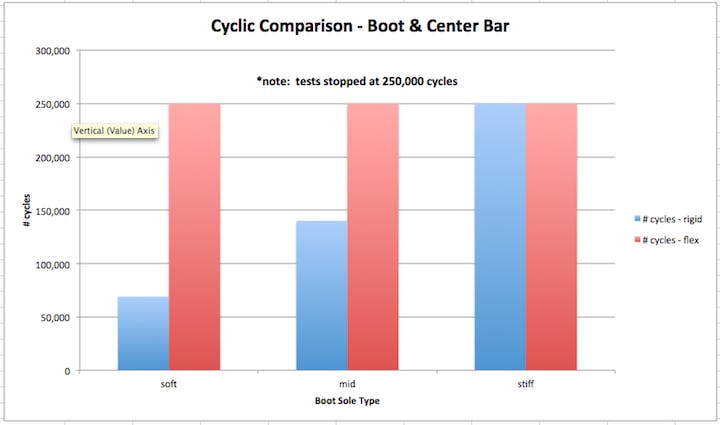
The results show that the softer the boot, the fewer number of cycles the crampon frame can take before metal fatigue—which makes sense since the crampon ends up taking the bending load. The results also show that using a flexible center bar can greatly increase the life of your crampon. Currently all horizontal front point crampons (the Sabretooth, Serac, Contact and Neve) come equipped with flexible center bars, and the vertical front point crampons (Stinger and Cyborg) are equipped with rigid center bars. Performance-wise, flexible center bars improve walking performance, but result in a slightly reduced technical performance.
Once again, the Brits got it right in the BMC pamphlet:
Also the crampon bends slightly, even on the stiffest boot, and this happens on every step. Metal will break flexed back and forward enough times (fatigue failure).
i) Choose a crampon suitable for your boot type – putting fully rigid crampons on flexible boots may damage the boots, the crampons and possibly your feet into the bargain.
ii) Choose a crampon appropriate for your intended use – using highly technical crampons for walking on mixed terrain will increase the likelihood of fatigue failure. Similarly, using crampons with long front points for climbing on rock will probably result in broken front points very quickly!
iii) Regular inspection – be aware that your crampons take the most abuse of any of your mountaineering equipment so be extra vigilant with frequent inspections.
Care and Maintenance:
Proper use care and maintenance is crucial to increasing the usable lifespan of your gear. Inspect your gear often. Read the manufacturer's instructions. Click here to download ours, and read below for excerpts from other companies' instructions, all of which provide similar directions for care and maintenance.
LIife of crampon:
- Sporadic use with a seasonal concentration = between 5 and 10 years.
- Regular use throughout the year on difficult routes and some ice falls = between 3 and 5 years.
- Frequent, professional use on new routes and ice falls = between 3 and 6 seasons.
- Dry tooling, modern mixed, competitions = between 1 and 2 seasons.
In addition to the normal inspection required before, during and after each use, this product should be annually examined by a competent person; the recording of this check should be done on the life sheet of
the product.
Before using the crampons check that the binding system fits the boots that
will be used. Only use crampons with a flexible linking bar on soft mountaineering boots.
Maintenance and lifespan
Check your crampons before, during and after each use. Check that there are no cracks on the metallic parts.
A more thorough examination shall be made at least every year by a competent and trained person. The maximum lifespan of the crampon is 5 years of use. This lifespan can be reduced to one single use in case of severe load (fall). If you have any doubt about any piece of gear, retire and destroy it.
Bottom line
Yowsa. This is one seriously long QC Lab post! So what does all of this data and info mean? The bottom line:
- Vertically oriented front points are best for climbing water ice and/or heavy climbers, and tend to do better in cyclic fatigue.
- Horizontal front points are best used for the alpine.
- Flexible center bars can increase the lifespan of your crampons, but at a cost of performance.
- Boots aren't as rigid as they used to be and break down/wear in quicker.
- Use flexible center bars with truly non-rigid boots.
- Regardless of the version or model of BD crampon you own, when matched with appropriate boots and center bars, they can be trusted perform to the highest of standards.
- Just like with ice picks, no one has a magic material or process that produces an unbreakable crampon.
Gear doesn't last forever.
Regardless if the gear is new age or old school, lightweight or heavy, Black Diamond or any other manufacturer, no climbing gear will last forever. Climbers should know the limitations of their gear, its appropriate use, and inspect often. If you take care of your climbing gear and use it in the proper application, it will last longer. And, as always, if you're questioning the strength or usability of a piece of gear, retire it.
Stay tuned for Part Three in this series in a few weeks, were we'll cover slings and quickdraws.
Be safe out there —
KP


